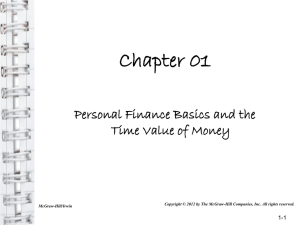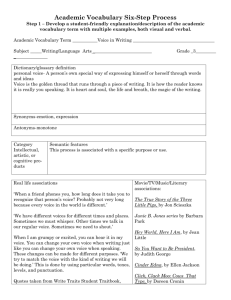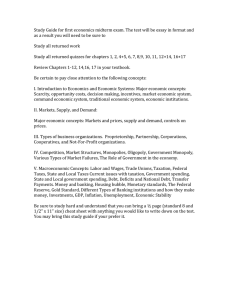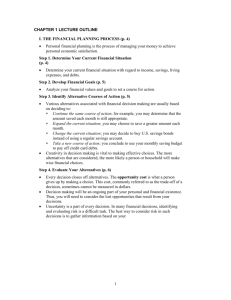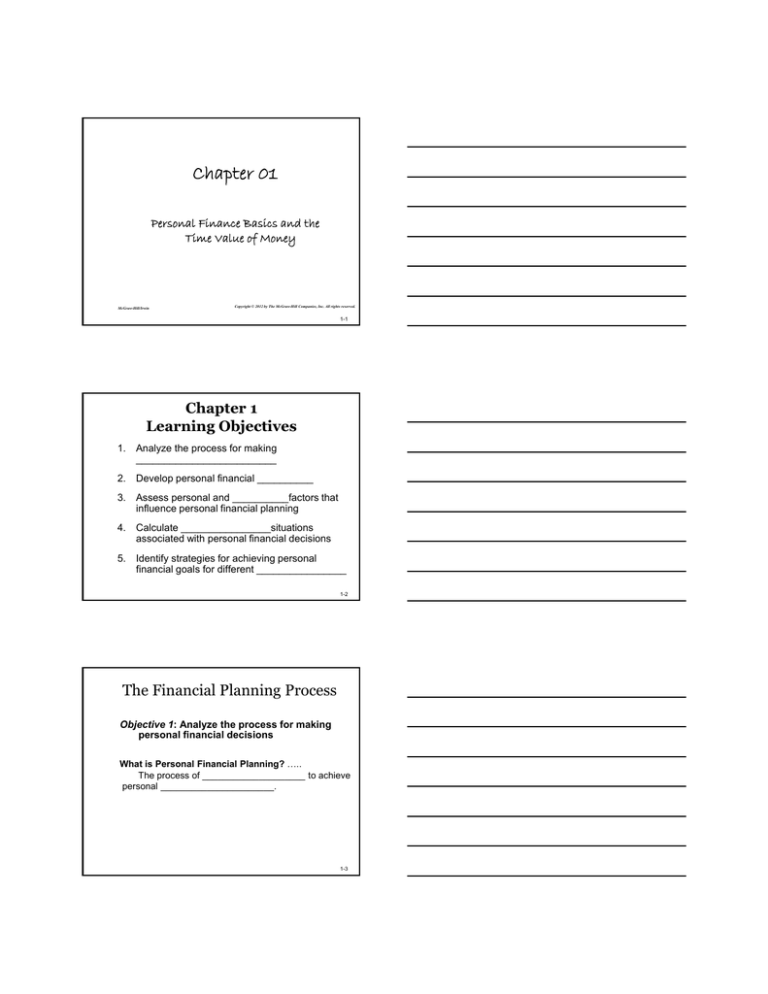
Chapter 01
Personal Finance Basics and the
Time Value of Money
McGraw-Hill/Irwin
Copyright © 2012 by The McGraw-Hill Companies, Inc. All rights reserved.
1-1
Chapter 1
Learning Objectives
1.
Analyze the process for making
_________________________
2.
Develop personal financial __________
3.
Assess personal and __________factors that
influence personal financial planning
4.
Calculate ________________situations
associated with personal financial decisions
5.
Identify strategies for achieving personal
financial goals for different ________________
1-2
The Financial Planning Process
Objective 1: Analyze the process for making
personal financial decisions
What is Personal Financial Planning? …..
The process of ____________________ to achieve
personal ______________________.
1-3
The Financial Planning Process
Advantages of Personal Financial Planning are:
1.
Increased effectiveness in obtaining, using and
protecting financial resources.
2.
Increased control of one’s financial affairs
3.
Improved personal relationships
4.
Sense of freedom from financial worries
1-4
Six-step Procedure for Financial
Planning
Continued…
1-5
Six-step Procedure for Financial
Planning
Step 1: DETERMINE YOUR CURRENT
___________________________
•
Evaluate income, savings, living
expenses, and debts
•
Prepare a list of current asset and debt
balances and amount spent for various
items
•
Match financial goals to current income
and potential earning power
Continued…
1-6
Six-step Procedure for Financial
Planning
Step 2: DEVELOP YOUR FINANCIAL
________________
• Identify feelings about money and the
reasons for those feelings
• Determine the source of your feelings about
money
• Determine the effects of the economy on your
goals and priorities
• Make sure that your goals are your own and
are specific to your situation
Continued…
1-7
Six-step Procedure for Financial
Planning
Step 3: IDENTIFY ALTERNATIVE _________
____________________
• Possible courses of action can be:
– Continue the same course of action
– Expand the current situation
– Change the current situation
– Take a new course of action
Continued…
1-8
Six-step Procedure for Financial
Planning
Step 3: IDENTIFY ALTERNATIVE
COURSES OF ACTION (continued)
• Creativity in decision making is vital to
effective choices
• “______________” can be a dangerous
alternative
Continued…
1-9
Six-step Procedure for Financial
Planning
Step 4: EVALUATE _________
__________________
• CONSEQUENCES OF CHOICES
– ___________________ - What you give up
when you make a choice
– The cost or __________ of a decision cannot
always be measured in dollars. Sometimes
the cost is your time
Continued…
1-10
Six-step Procedure for Financial
Planning
Step 4: EVALUATE YOUR
ALTERNATIVES
• EVALUATING ______________
– Uncertainty is a part of every decision.
– Best way to analyze and minimize risk is to
gather information from financial planning
sources.
Continued…
1-11
Six-step Procedure for Financial
Planning
Step 5: CREATE AND IMPLEMENT YOUR
___________________________________
– Develop an action plan that identifies ways to
achieve financial goals
– Possible action plans can be increasing savings,
reducing spending, or making provisions for
taxes
– To implement action plans you may need
assistance from others
Continued…
1-12
Six-step Procedure for Financial
Planning
Step 6: _________ AND _______ YOUR PLAN
• Financial planning decisions need to be assessed
regularly
• Complete review should be done at least once a
year
• More frequent reviews may be required for
changing personal, social, and economic factors
• Regular reviews of decision-making process can
help in making priority adjustments to achieve
1-13
financial goals
Developing Personal Financial Goals
Objective 2: Develop personal _____________
• TYPES OF FINANCIAL GOALS can be:
a) Influenced by
the ___________
in which you want
to achieve your
goals
b) Influenced by the
_________ need
that drives your
goals
1-14
Developing Personal Financial
Goals
Objective 2: Develop personal financial goals
• TIMING OF GOALS
– Short-term, intermediate and long-term goals
– Long term goals should be planned in coordination
with short-term and intermediate goals
• GOALS FOR DIFFERENT FINANCIAL NEEDS
– Consumer product goals
– Durable-product goals
– Intangible-purchase goals
1-15
Developing Personal Financial
Goals (continued)
GOAL-SETTING GUIDELINES
• Goals should be:
– S_____: know what your goals are to create a plan
– M____________: with a specific amount
– A_______________: identify the personal financial
activities
– R________: utilizing your income and life situation
– T_________: identify the time frame to achieve the
goal
1-16
Influences on Personal Financial
Planning
Objective 3: Assess _________ and
___________ factors that influence
personal financial planning
LIFE SITUATION AND PERSONAL VALUES
• ____________________ stage
• Marital status, household size, and employment
• Major events
– Graduation, marriage, career change, children,
retirement, etc.
• Values influence spending and saving decisions
1-17
Influences on Personal Financial
Planning (continued)
ECONOMIC FACTORS
• ______________ is the study of how wealth is
created and distributed
• Federal Reserve Bank and it’s role in the
economy
1-18
Influences on Personal Financial
Planning (continued)
GLOBAL INFLUENCES
• Global marketplace influences financial
activities
• American companies compete against foreign
companies for US dollars
• Balance of exports and imports
• Foreign investments and their role in the US
Money Supply
• The level of Money Supply affects interest
rates
1-19
Influences on Personal Financial
Planning (continued)
ECONOMIC CONDITIONS
•Consumer prices
•Consumer spending
•Interest rates
•Money Supply
•Unemployment
•Housing Starts
•Gross domestic product (GDP)
•Trade balance
•Stock market indexes
1-20
Tools in every financial situation
•
•
•
•
•
•
Reduce debt usage
Reduce spending
Review savings investments
Evaluate insurance coverage
Avoid financial scams
Communicate with family
1-21
Influences on Personal Financial
Planning (continued)
1-22
Opportunity Costs and the
Time Value of Money
• Every financial decision involves giving up
something to obtain something else
PERSONAL ________________________
• Time
• Other personal opportunity costs can be related to
health, leisure etc.
• Personal resources like financial resources
require careful management
1-23
Opportunity Costs and the Time
Value of Money (continued)
FINANCIAL OPPORTUNITY COSTS
______________________
• Increases in an amount of money as a
result of interest earned
• Saving today means more money tomorrow.
Spending means lost interest.
• Saving and spending decisions involve
trade-offs. Current needs can make
spending worthwhile.
1-24
Future Value Example
You deposit $100 today in a bank account
that pays 3% interest per year. How much
do you have in 1, 2 and 3 years?
1-25
Opportunity Costs and the Time
Value of Money (continued)
1) _____________ OF A SINGLE AMOUNT
• Future value is the amount to which current
savings will increase based on a certain interest
rate and a certain time period
• Future value is also call compounding - earning
interest on previously earned interest
2) FUTURE VALUE OF A SERIES OF
DEPOSITS
• Future value can be computed for a single
amount or for a series of deposits called an
_______________
1-26
Future Value of an Annuity
• You deposit $100 in each of the next 3
years (starting next year) in a bank
account that pays 3% interest per year.
How much do you have 3 years from now?
27
Future Value Formulas
28
Present Value Example
You want $500 in three years. How mucg
must you deposit today in a bank account
that pays 3% interest per year?
1-29
Opportunity Costs and the Time
Value of Money (continued)
3) _________________ OF A SINGLE AMOUNT
• _________________ is the current value of a future
amount based on a certain interest rate and a certain
time period
• Present value calculations are also called discounting
• The present value of the amount you want in the future
will always be less than the future value.
4) PRESENT VALUE OF A SERIES OF DEPOSITS
• Present value can be computed for a single amount or
for a series of deposits.
1-30
Present Value of an Annuity
• How much do you need to deposit today in
a bank account that pays 3% interest per
year if you plan to withdraw $250 per year
for three years, starting next year?
31
Present Value Formulas
32
Achieving Financial Goals
Objective 5: Identify __________ for achieving
personal financial goals for different life situations
COMPONENTS OF PERSONAL FINANCIAL PLANNING
• Obtaining (chapter 2)
• Planning (chapters 3, 4)
• Saving (chapter 5)
• Borrowing (chapters 6, 7)
• Spending (chapters 8, 9)
• Managing risk (chapters 10-12)
• Investing (chapters 13-17)
• Retirement and estate planning (chapters 18, 19)
1-33
Achieving Financial Goals (continued)
DEVELOPING A _________ FINANCIAL PLAN
• A financial plan is a formalized report that...
– Summarizes your current financial situation
–
Analyzes your financial needs
–
Recommends future financial activities
• Your financial plan can be created by you, with
assistance from a financial planner, or made
using a money management software package
1-34
Achieving Financial Goals (continued)
IMPLEMENTING YOUR FINANCIAL PLAN
• Develop good financial habits
–
Use a well conceived spending plan to help you
stay within your income, while allowing you to
save and invest for the future
–
Have appropriate insurance protection to
prevent financial disasters
–
Become informed about tax and investment
alternatives
1-35

